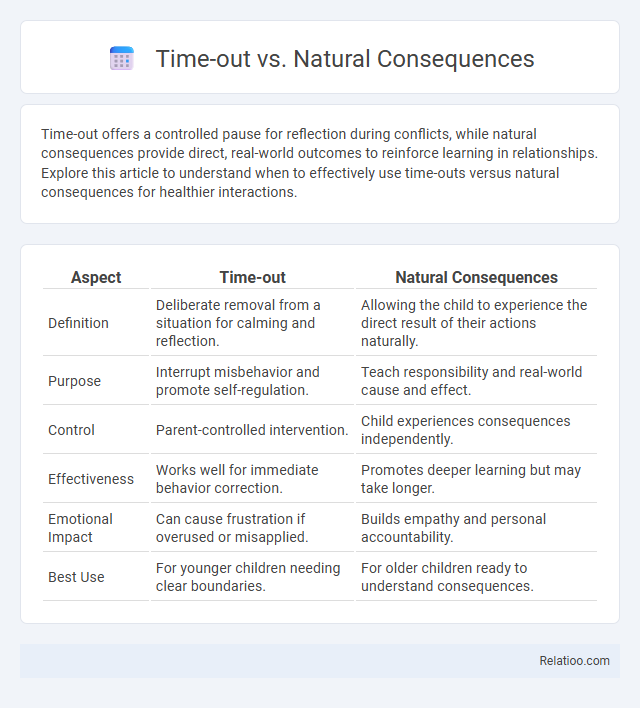Time-out offers a controlled pause for reflection during conflicts, while natural consequences provide direct, real-world outcomes to reinforce learning in relationships. Explore this article to understand when to effectively use time-outs versus natural consequences for healthier interactions.
Table of Comparison
| Aspect | Time-out | Natural Consequences |
|---|---|---|
| Definition | Deliberate removal from a situation for calming and reflection. | Allowing the child to experience the direct result of their actions naturally. |
| Purpose | Interrupt misbehavior and promote self-regulation. | Teach responsibility and real-world cause and effect. |
| Control | Parent-controlled intervention. | Child experiences consequences independently. |
| Effectiveness | Works well for immediate behavior correction. | Promotes deeper learning but may take longer. |
| Emotional Impact | Can cause frustration if overused or misapplied. | Builds empathy and personal accountability. |
| Best Use | For younger children needing clear boundaries. | For older children ready to understand consequences. |
Introduction to Discipline Strategies
Time-out involves temporarily removing a child from a situation to reduce undesirable behavior, while natural consequences allow children to experience the direct results of their actions, fostering learning through experience. Understanding these discipline strategies helps you choose methods that promote accountability and self-regulation tailored to your child's needs. Balancing time-out with natural consequences supports effective behavior management and emotional development.
Defining Time-Out: Purpose and Process
Time-out is a behavioral strategy designed to temporarily remove a child from a situation to reduce disruptive behavior and promote self-regulation. Its purpose is to give the child a clear signal that certain actions are unacceptable while providing a calm environment for reflection without distractions. The process involves brief isolation, typically in a designated quiet space, ensuring consistency and clarity in application to be effective.
Understanding Natural Consequences
Understanding natural consequences involves allowing children to experience the direct results of their actions without parental intervention, fostering responsibility and critical thinking. Unlike time-outs, which involve removing a child from a situation to calm down or reflect, natural consequences provide immediate, real-world feedback that deepens learning and internalizes appropriate behavior. Emphasizing natural consequences promotes long-term behavioral change by encouraging children to connect actions and outcomes more effectively than imposed discipline methods such as time-outs.
Psychological Principles Behind Each Approach
Time-out leverages behavioral psychology by temporarily removing a child from a reinforcing environment to decrease undesirable behavior, emphasizing immediate consequence and self-regulation. Natural consequences rely on experiential learning, allowing children to experience the direct results of their actions to foster intrinsic understanding and responsibility without external intervention. Both approaches harness the principle of operant conditioning, but time-out introduces external control while natural consequences promote autonomous learning and decision-making.
Age Appropriateness for Time-Out and Natural Consequences
Time-out is most effective for children aged 2 to 6 years, providing a clear, consistent pause that helps them regulate behavior through brief isolation. Natural consequences suit older children, typically above 6 years, as they encourage learning through real-world outcomes without adult-imposed punishments. Age-appropriate discipline balances structured time-outs for younger children with natural consequences that foster responsibility and decision-making skills in older kids.
Effectiveness: What the Research Says
Research shows time-out techniques reduce immediate misbehavior by providing a clear, consistent boundary, while natural consequences teach long-term responsibility by allowing your child to experience the results of their actions. Studies find that combining time-out with natural consequences often enhances effectiveness, promoting both behavioral correction and internalized understanding. Effectiveness varies depending on child temperament and implementation consistency, with positive reinforcement further increasing long-term behavioral improvements.
Pros and Cons: Time-Out vs Natural Consequences
Time-out allows Your child to pause and reflect on misbehavior in a controlled environment, promoting self-regulation but may lead to feelings of isolation if overused. Natural consequences offer realistic learning experiences by letting children face the direct results of their actions, fostering responsibility yet sometimes risking safety or delayed lessons. Balancing both approaches helps maximize behavioral growth while considering emotional impact and practical outcomes.
Common Misconceptions and Myths
Time-out is often misunderstood as a punishment rather than a calm-down period, while natural consequences are mistakenly seen as neglecting parental responsibility when they actually teach cause and effect through real-life outcomes. Many believe that time-out and natural consequences are interchangeable, but time-out involves removing access to reinforcing stimuli, whereas natural consequences let your child experience the direct results of their actions. Clarifying these myths helps you apply discipline strategies effectively, ensuring they support positive behavior and development.
Integrating Both Approaches in Parenting
Integrating time-out and natural consequences in parenting enhances discipline by balancing structured interventions with real-life learning experiences. Applying time-outs helps children pause and reflect on inappropriate behavior, while natural consequences allow them to understand the real-world impact of their actions. This combined approach promotes emotional regulation and accountability, fostering long-term behavioral development.
Conclusion: Choosing the Best Strategy for Your Family
Choosing the best strategy for your family depends on understanding the distinct benefits and applications of time-out, natural consequences, and positive reinforcement. Time-out offers clear boundaries and immediate behavior correction, while natural consequences provide experiential learning that promotes long-term responsibility. Your approach should align with your child's unique temperament and your family's values to foster effective discipline and growth.

Infographic: Time-out vs Natural Consequences
 relatioo.com
relatioo.com